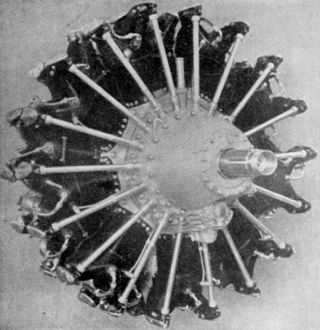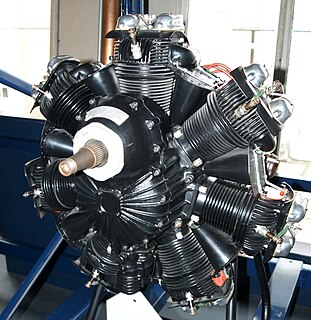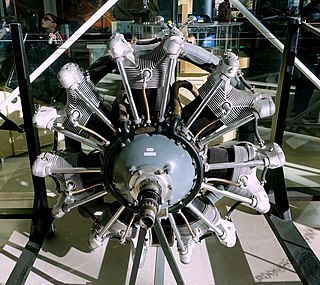
The BMW 132 was a nine-cylinder radial aircraft engine produced by BMW starting in 1933.

The Armstrong Siddeley Mongoose is a British five-cylinder radial aero engine produced by Armstrong Siddeley. Developed in the mid-1920s it was used in the Hawker Tomtit trainer and Parnall Peto seaplane amongst others. With a displacement of 540 cubic inches (9 litres) the Mongoose had a maximum power output of 155 horsepower (115 kilowatts).

The Warner Scarab is an American seven-cylinder radial aircraft engine, that was manufactured by the Warner Aircraft Corporation of Detroit, Michigan in 1928 through to the early 1940s. In military service the engine was designated R-420.

The Fiat A.80 was an 18-cylinder, twin-row, air-cooled, radial aircraft engine produced during World War II. Rated at 1,000 hp (745 kW), it was a more powerful development of the 14-cylinder Fiat A.74.
The Warner Scarab Junior was an American, five-cylinder, air-cooled, radial aero engine first produced in 1930. It was a scaled-down derivative of the seven-cylinder Warner Scarab, developing 90 hp (70 kW) against the Scarab's 110 hp (80 kW).

The Fiat A.74 was a two-row, fourteen-cylinder, air-cooled radial engine produced in Italy in the 1930s as a powerplant for aircraft. It was used in some of Italy's most important aircraft of World War II.

The Kinner B-5 was a popular five cylinder American radial engine for light general and sport aircraft of the 1930s.

The Pobjoy Niagara is a British seven-cylinder, air-cooled, radial, aero-engine first produced in 1934. The design ran at higher speeds than conventional engines, and used reduction gearing to lower the speed of the propeller. This led to a noticeable off-centre mounting for the propeller. The Niagara was a popular engine for light and experimental aircraft, well regarded due to its small diameter, smooth operation, low noise and innovative engineering.

The Wright R-540 Whirlwind was a series of five-cylinder air-cooled radial aircraft engines built by the Wright Aeronautical division of Curtiss-Wright. These engines had a displacement of 540 in³ (8.85 L) and power ratings of around 165-175 hp (123-130 kW). They were the smallest members of the Wright Whirlwind engine family.

The Jacobs R-915 or Jacobs L-6 is a seven-cylinder, air-cooled, radial engine for aircraft manufactured in the United States, production started in 1936.
The Jacobs R-830 or L-5 is a seven-cylinder, air-cooled, radial engine for aircraft manufactured in the United States, production started in 1935.

The Alvis Pelides was an unflown British air-cooled radial aero engine first developed in 1936. The Pelides Major was a projected but unbuilt development as were the Alcides, Alcides Major and the Maeonides Major, the Alvis aircraft engine range taking their names from Greek mythology.

The Bristol Neptune was a seven-cylinder air-cooled radial engine developed in 1930. It had the same size cylinders as the earlier Mercury and Titan engines, 5.75 in (146 mm) x 6.5 in (165 mm) which gave a displacement of 1,182 cu in and produced a maximum of 320 horsepower (239 kW). The Neptune was effectively a seven-cylinder version of the Titan.
The Kinner C-5 was an American five cylinder radial engine for small general and sport aircraft of the 1930s.

The Wolseley Aries III or A.R.9 was a British nine-cylinder, air-cooled radial aero engine that first ran in 1933, it was designed and built by Wolseley Motors. Intended for the military trainer aircraft market few were produced as Wolseley withdrew from the aero engine market in 1936.

British Salmson aero-engines refers to a series of small French designed, air-cooled radial aero engine that were produced by British Salmson Aero Engines Ltd, under license from Société des Moteurs Salmson, in Great Britain during the late 1920s and 1930s.

The Walter Regulus was a Czechoslovakian five-cylinder, air-cooled radial engine for powering light aircraft that first ran in 1934. The engine produced 186 kW.

The Walter Sagitta was a Czechoslovakian, air-cooled, inverted V-12 engine that first ran in 1937. This was one of several smaller, low-mass medium power pre-war V-12 engines produced. With a displacement of 18.4 liters, it produced up to 373 kW at 2,500 rpm.

The Continental O-526 is a family of air-cooled flat-6 aircraft piston engines built by Teledyne Continental Motors.

The Walter Atlas was a nine-cylinder, air-cooled, radial engine for aircraft use built in Czechoslovakia in the early 1930s.


















